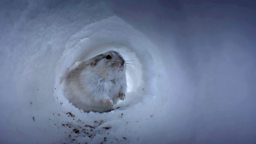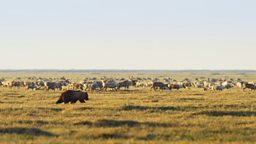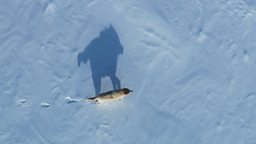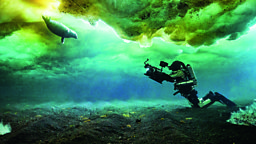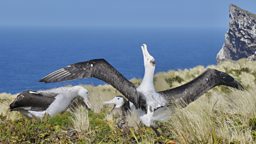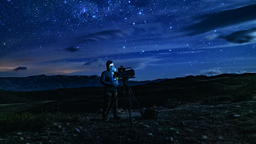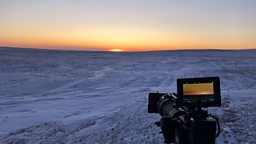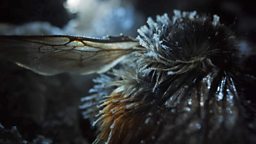Polar bear island
By Sacha Thorpe, director for Frozen Planet II
In late August 2019 we set off for the remote island of Wrangel in Russia’s north-eastern Arctic. The size of Crete, Wrangel is so cut off that the very last population of woolly mammoth survived there thousands of years after going extinct in the rest of the world. Today, the island harbours the greatest concentration of polar bears on the planet.
an estimated thousand or more bears swim to its shores
Every summer, an estimated thousand or more bears swim to its shores, as they wait for the sea ice to return. And because of climate change, that wait is becoming longer and longer. To survive the bears are forced to scavenge for whatever food they can find, and it is this story we wanted to tell.
We were headed to Wrangel to find polar bears - we didn’t know just how close we would get to them.
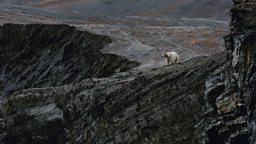
Travelling to the island
It took three weeks to reach the island. Two of those were spent stranded in the small Soviet-era town of Bilibino, still an 8 hour helicopter ride from Wrangel. We stared every day at satellite imagery of a bank of low clouds steadfastly refusing to lift over the strip of ocean separating the island from the mainland. Too dangerous to fly through.
Life there is tough. In winter, temperatures rarely exceed -25 °C
We were ready to pack up and head home when one morning the forecast predicted a few hours of clearer skies. We took the chance, and a tiny gap in the clouds provided just enough visibility for the helicopter to drop us off before the island was once again engulfed in fog.
Reaching the island was a huge relief for our team, consisting of cameramen John Aitchison and Olly Jelley and field medic Aleksandra Prasolova. We met up with our guide Gennadiy Fedorov, one of the handful of park rangers that live year-round on Wrangel. Life there is tough. In winter, temperatures rarely exceed -25 °C.
The rangers only get to leave the island once every year and a half. The rest of the time they live in small, basic wooden cabins with no internet or phone signal. Most don’t even have electricity. Gennadiy was in his third year, others have been doing it for over 40. But all share a love for the island. Gennadiy talks of the deep pull of its untouched, primal wilderness, believing that the island transforms anyone who visits it. When he returned to the mainland for the first time, he had just one wish – to come back.
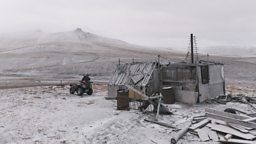
Filming polar bears
The density of bears on Wrangel is unlike anywhere else in the Arctic. As we travelled across the tundra it was never long before we spotted their impressive white mass against the island’s dark, slate encrusted rock.
The density of bears on Wrangel is unlike anywhere else in the Arctic
We focused our efforts on the western side of the island, home to a small walrus colony.
Adult walruses are too dangerous to attack for a bear, but it became clear that some had learned that causing a stampede resulted in walrus getting crushed to death. In turn, each carcass would attract dozens of bears.

Curious bears would often try and come towards us.
We tread a fine line trying to get close enough to film. Curious bears would often try and come towards us. Wrangel’s rangers are forbidden from carrying firearms. So, if one approached too closely, Gennadiy would walk towards the bear, staring it down while brandishing a large stick said to mimic a walrus tusk. It’s the ultimate game of chicken, reliant on never showing signs of hesitation. But it’s what allows the rangers to cohabit safely and peacefully with the bears.

A very special family
We were delighted with the material we were getting, but we still lacked a focus for the sequence. This all changed when we came across a mother bear and her two young cubs in a nearby cove.
Young bears are the most at risk from starvation during the ice-free months
Young bears are the most at risk from starvation during the ice-free months and we knew we wanted to tell the story of their travails.
Over several days we followed them combing the shoreline, avoiding other potentially dangerous bears and resorting to eating grass. Filming them was a challenge. We struggled to keep up with their pace, and the wary mother made sure they always stayed a far distance from us.
Then, one day, we returned to the cove to find the family gone. This was a huge blow, not yet having enough footage to build our sequence.

Our last filming day arrived and still no sign of the young family. Worse still the weather started to deteriorate. A gale force wind was blowing thick fog and sleet. Positioned near fresh walrus carcasses and half blinded by the wind and rain, we were quickly surrounded by bears on all sides. Gennadiy was struggling to keep them at bay. We considered making a hasty retreat when in the distance we noticed three familiar figures… It was our mum and her cubs.
Now was not the time to leave.
And then something remarkable happened.
Rather than keep their distance, the young family walked right up to us. They stood there, no further than 15 metres away, watching us. We were transfixed, but at no point scared. It was as if she was showing her cubs that we were no danger to them, that she trusted us. And in turn we trusted her. It lasted just a few minutes, but it is a moment none of us will ever forget.
What followed would form the climax of our sequence, as the mother tried desperately to feed while protecting her young against a large hungry male, twice her size. With rain pounding the lens and wind shaking the camera, it was all John could do to keep filming.
Eventually, showing extraordinary courage, the mother chased the bear away, allowing her cubs to feed in turn. Such were the conditions, we would only find out several weeks later if any of the footage was useable. Luckily for us it was.

The future of Wrangel’s bears
The next day, our last on the island, we were joined by biologists Eric Regher and Geoff York. Eric runs a joint American Russian program to count Wrangel’s bears and gather information on their health and feeding habits. His studies show that for now Wrangel’s bears are surviving. The washed up carcasses seem to be providing just enough food to sustain them until the return of the ice. But he is unequivocal when talking about the future of the species. If the Arctic summer ice continues to melt, there will come a time when what food there is on land is simply not enough. Some may adapt, but it will be a fraction of the numbers we see today. And families like the one we filmed will likely be the first to suffer.
If the Arctic summer ice continues to melt, there will come a time when there is simply not enough food on land for all.
As we stood on the beach, waiting to board a boat to take us off the island, we stood and watched as a large bear came towards us, eventually walking just a few metres away, before disappearing into the tundra. We said our goodbyes to the island, knowing we would never consider polar bears in the same way again.

